A Paipo Interview with Jack McCoy
June 1, 2010. Avalon Beach NSW, Sydney Australia
Questions and e-mail interview by Bob Green
Jack grew up in Hawaii and like many youth of the time rode a paipo.
Like many of his peers he moved onto riding a standup surfboard,
however, unlike many of his peers he has spent more time behind the
lens documenting the surfing life. Jack pays tribute to a stand-up
paipo rider, Valentine Ching, and also describes his recent experience
of riding paipo again.
|
1.When did your family move to Hawaii? What was your first surfing
experience?
I rode my first wave in Waikiki that my dad pushed me on. He cut his
foot and got blood poison and I got surfing in my blood that still
exists
today.
2. You've written that a friend, Mike Conway, helped you
make a paipo when you were about 11 or 12 years old. What do you recall
about the board and
it's construction?
We'd bought marine ply and a marine paint at the local hardware store.
Made the boards ourselves. Started using them the next day after
letting the
paint dry overnight [see Note 1]. |
|
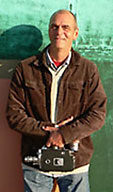 |
Jack with his 7'2" alaia. Of his Wegener 4'2" paipo,
Jack wrote, "Although narrower than the one I had as a kid, I've been
riding it a lot lately. I love it. It brings out the little kid in me.
I love the speed, it's like surfing on a bar of soap".
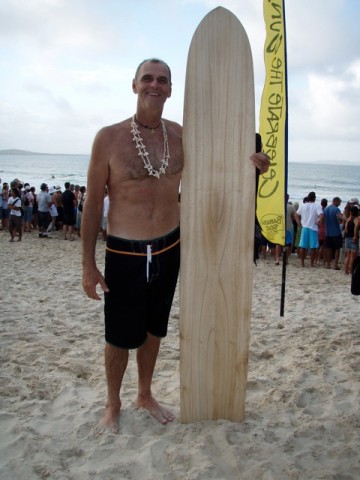
Photo courtesy Jack McCoy.
3. You've also said that you didn't use swim fins. What
was the technique involved to catch and ride waves? How did the board
ride?
Because we're talking about Kailua shorebreak, you could stand most of
the time where the waves were so fins were not really necessary.
The board went great as a sand slider and as a board to ride waves.
However, whether it was a good or bad design I have no idea. We were
just stoked to make our own boards and then ride them.
4. Where did you surf the board? Were there many other
people riding paipo? Were these mainly kids?
Yeah, Kailua had heaps of us little grommets all hanging at the beach
all day doing everything we could in the water.
5. How long did you ride a paipo board?
I'm still riding paipo boards today, but when
I got my first surfboard I was pretty focused on board riding. I've
continued throughout my life
to bodysurf and paipo occasionally, and then of course, boogie boarding.
There was a period when we moved from Kailua to Hawaii Kai area and we
spent a lot of time bodysurfing at Sandy's and Makapu`u. Sometimes we'd
ride a
paipo at half point Sandy's or Makapu`u when it was breaking way
outside.
6. Do you recall which surfing film sparked a desire to
be involved with surfing films? What was the attraction?
My first Bruce Brown movie at my school was
the big eye opener for me. It was a a great experience with Bruce
selling tickets, introducing the
show, killing the lights and starting the projector .... having a yack
at half-time, then another yack after the show. He could see how stoked
I
was. I'm sure and he went out of his way to be kind to me and I went
home thinking I want to do what that guy does.
7. Surf films from the 1960s used to include the
occasional ride by a paipo rider, especially the films of Val
Valentine, who for a while made and distributed Paipo Nui boards. Do
you recall seeing paipo footage from that time? What was the audience
reaction to such footage?
There was the odd paipo ride in some of the earlier films, but it never
got the hoots a great wipe out or ride got. I do remember Val's footage
in a couple of his films and most of us were not really that interested
at that time to appreciate it. The guys who I saw personally ride them
on trips to the country were usually bouncing around so much in the big
North Shore surf it didn't seem that attractive to me then [see Note 2].
8. Did you ever meet Val Valentine? After Val's death,
Paul Swanson, a well known stand-up surfer and paipo rider, was left
Val's boards [see Note 3 ]. Do you know what became
of his surfing films?
Val Valentine was a very cool dude. He drove a
convertible MG or something like that. Very approachable in person. He
also opened up his front yard to anyone when the surf was up and he was
a big promoter of paipo surfing and I believe he also invested in the
plywood spoon type that you see being ridden in his films.
9. From putting up surf posters at age 12, to
distributing films for 10 years, then producing Tubular Swells
in 1975 - when did you first start to think that you'd like to make a
surf film?
I never thought of making a film, I was always
in awe of the guys who did. I spent my time distributing them and it
wasn't until I had a skiing accident that my distribution partner, Dick
Hoole, put a Bolex 16mm camera in my hand in 1975, and said "we're
making a surf movie" did I begin to think of making one. I still tell
people that the first
one was the best because everything was all new. The result was Tubular
Swells.
Tubular Swells poster
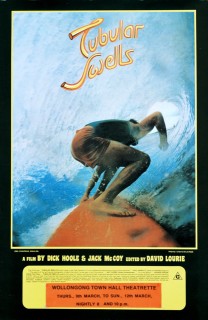
Photo courtesy Jack McCoy.
10. You made over 20 surfing films and continue to make
films, despite a market dominated by video/DVDs. DVDs can be fun
because you can sit back and watch them over and over in the comfort of
your own home. Watching a surf movie surrounded by surfers is, however,
a very different type of experience. Why do you keep making movies?
Because there is nothing like watching a surf
movie surrounded by other surfers …… chicken skin.
With Blue Horizon and Free As A Dog, I was at and
introduced 160 showings to 60,000 people in 10 countries for each film.
Each night I'd go in and watch the whole thing, or parts of the film. I
wanted to hear the crowd reaction. We didn't make any money from either
tour when you consider the effort we put into it, but very, very rich
in sharing the stoke and getting the feedback first hand.
11. Bob McTavish's name is associated with the
"shortboard revolution." However, Val Ching was performing progressive
stand-up surfing on a paipo around 1963 - do you know any of the story
regarding who took the footage and it's current availability?
When Derek Hynd and I were researching for A
Deeper Shade Of Blue, all of the so-called "shortboard revolution"
pointed to George Greenough.
Yes, Val was standing up on his paipo that he had a fin on, but Wally
Froiseth was standing up, too, way before Val. And the ancient
Hawaiians were standing up on alaia's. I'm not a big believer in those
who like to take credit for things that were obviously out and about
way before some people, but I believe the right word might be
"popularise" a style or design to those people.
Wally Froiseth stand-up paipo
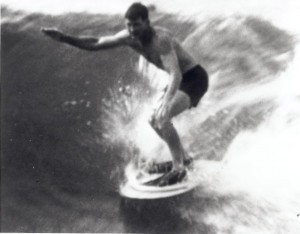
Photo courtesy Wally Froiseth.
12. In 2006, you premiered Free As A Dog with
footage of Val Ching surfing China Wall. Why do you think this footage
still resonates with audiences?
That was in my film Blue Horizon and
the shot was at the Waikiki Wall. China Walls is what they call the
Portlock Point these days, an epic spot to paipo when small, hugging the
cliff. I worked for a shake roofing company for a couple of summer
vacations and whenever I was working on the houses right there
overlooking the point, I'd grab the biggest "shake" and go ride the
peelers all by myself during lunch hour.
The footage of Val has always been very special to me and I'm glad that
people appreciate it [see Note 4].
Val Ching
standup paipo c.1963.
|
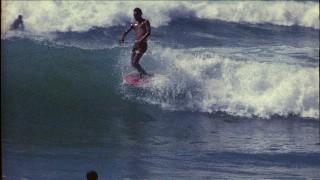
|
|
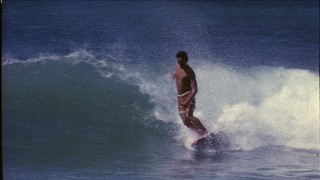
|
Photos by Val Valentine, courtesy Jack McCoy.
13. In addition to the alaia have you come
across people riding paipo or bellyboards in your travels or seen much
footage?
No paipo surfing. Wood paipo surfing is not
that popular. Of course, boogie boarding is paipo riding these days and
we all know how popular that is.
Four years ago Tom Wegener got me back into it when he gave me a 7' 2"
alai'a that I can't stand up and surf on, but I've been riding it prone
ever since. He just gave me another one this year at the Noosa Fest and
I rode it Friday and Saturday all day while up there and had a ball.
Been riding it pretty much exclusively for the past 4 months.
The board Tom gave me is paulownia like his alai'a, its 4' 2" and about
17 inches wide and really thin. LOVE IT. Best waves? Noosa at 10 foot,
back in the tub ..... Flying on what feels like a bar of soap.
Had a great session at a Horseshoe right bowl on the south coast that
ran a wall into itself that was crazy. That's the day I really
understood the board and used the flex to take some rad drops straight
into the tube. Fun. Also have had some great surfs around Avalon where
I live.
I've just been trying to ride it everywhere. It takes me back to my
roots. A really great feeling. A bit lazy maybe, just too easy keeping
it in the back of the car, wettie on, grab the fins and you're out
there.
14. As a long-time observer of surfing, any other
comments?
Having fun is half the fun, Keep having fun
with Alo HA!
Jack's latest movie, A Deeper Shade of Blue
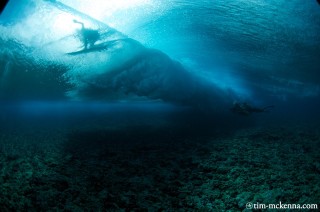
Photo courtesy
adeepershadeofblue.com. Photo by tim-mckenna.com.
|
Note 1:
More from Jack: "A hapa haole friend named Mike Conway helped me make
my first paipo/sandslider board when I was probably about 11 or 12 years old. We
rode our bikes to Kailua Hardware and bought some pieces of marine
plywood. We took the wood back to his house and cut them out, based on
what we'd seen some of the older kids down at the beach riding.
Once cut out, we took a grinder to the edges and shaped the rails all
the way around bevelled up. Finish sandpaper took out any of the rough
edges to our boards and then we painted them with a marine paint we'd
also purchased. It was red from memory. Anyway this board became my
best friend at the beach where we would ride waves and sand slide at
low tide."
Val Ching, 1963.
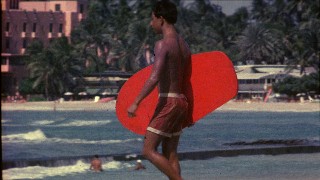
Photo by Val Valentine. Courtesy
Jack McCoy.
Note 2: Val Valentine's film's
included: Northside Story (1963), The Call of the Surf (1964), Surfing
Aussie (1965) and Outside (1966). Source:
http://www.surfclassics.com/complete.htm.
Note 3: A story on Paul with
photos of Valentine's and Swanson's paipo can be found in: Pu'u, David.
(2000, Summer). Mothball Fleet: A Moment with David Swanson, Paipo Boarder, in
“Undercurrents.” The Surfer’s Journal, 9(3), 122-123.
Note 4: Wally Froiseth is
featured in Gault-Williams, Malcolm. (1997, Winter). Surf Drunk.. The Wallace Froiseth
story, The Surfers Journal, 6(4), 94-109. Val Ching is featured in
Pendarvis, Cher. (2010, Winter). Uncle Val. Paipo in practice. The living link to surfing's
high-performance roots. The Surfers Journal, 19(6), 38-47.
Some more recollections from Jack McCoy and the importance of
Val Ching:
"A couple of years or so later I got my first board. A 9
ft 6 in Inter Island. The paipo took a back seat in my life at that
time. Mostly we surfed the 1 - 2 ft onshore Kailua shore break but once
in a while my mom would drive us over the Pali to Waikiki and drop us
off at Ft DeRussey where we'd paddle out to Pop's and surf till mid
afternoon before coming in starving. There was a little shop on the
beach where we could get a hot dog and a coke that was quickly inhaled
before ordering another and then with just enough money to buy a packet
of M and M's for dessert.
We'd go visit Mrs Take' s board short shop and check out the new
colors, and patterns she'd be bringing in, dreaming about saving up for
our next custom pair.
After the feed and a little hang near the board rentals, we'd walk down
to the Waikiki Wall to wait for my moms pick up. We'd go out to the end
of the wall and watch the kids who, like me a year or so ago, could not
afford a board and used the standard plywood paipo boards to have a
ball. I have a clear memory of the guy who had the red paipo and surfed
it standing up. He was sooooo cool and had such style. He was our
favourite rider. Someone told me that his name was Val.
I later saw him in Val Valentine's surf movie at my intermediate school
auditorium. He got a bunch of big hoots at the show. It's funny how
things go around in your life. Many years later I'd be asked to look
after some of Val Valentine's work. The paipo sequence was always a fav
and I restored it.
I always found it interesting that this little bit of Hawaiian culture
was shot by a guy name Val Valentine and it was Valentine Ching, Jr., who
was surfing. Cool huh? Meant to be, right?
Anyway these images are historically important for surfing as the paipo
was as popular back then as the boogie board is today, and beside a
couple of shots by Bud Browne that I know of, there is not that much
footage of the art.
Another meant to be crossing of paths came a couple of years ago when I
met Val Valentine, Jr., in person for breakfast during the Duke Festival.
It was an honor to connect and hear his stories about his paipo days
that I hope will be told over and over again.
That night I premiered my film Free As A Dog downtown in a theatre and
asked Val to come along. Without telling him I introduced him to the
audience and then, before my film, I showed a 3 min piece I'd put
together his paipo surfing. The crowd cheered from start to finish.
Thank you Val for the memories. There were many of us on paipo's back
then that believed you were "the man," and It's great to hear about all
the Hawaiian culture work you do now. Your still are "the man" today."
|
|